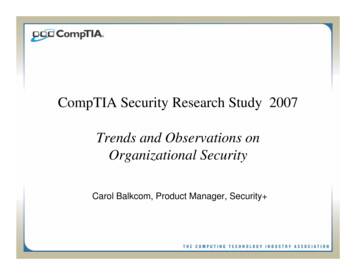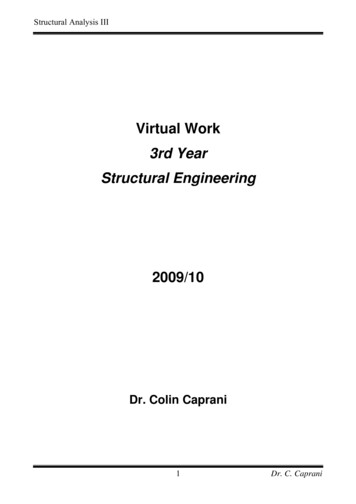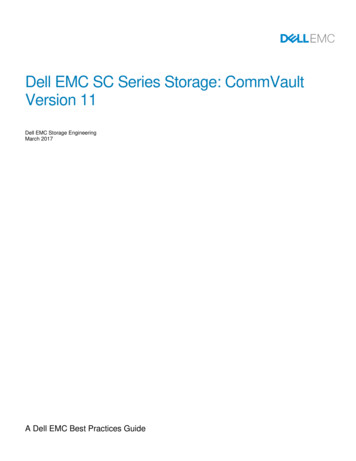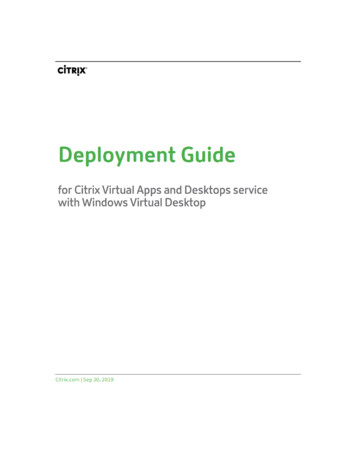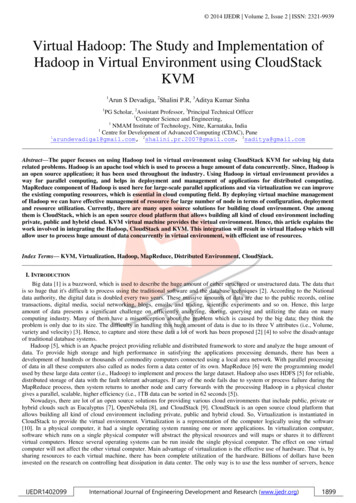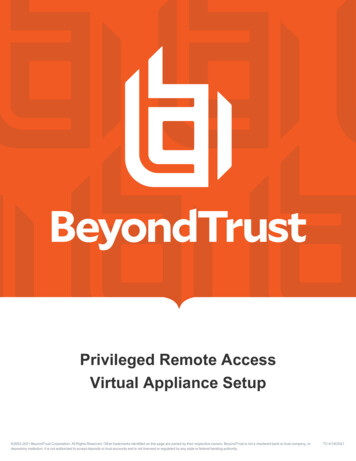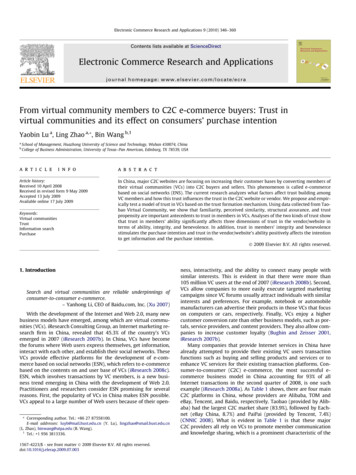
Transcription
Electronic Commerce Research and Applications 9 (2010) 346–360Contents lists available at ScienceDirectElectronic Commerce Research and Applicationsjournal homepage: www.elsevier.com/locate/ecraFrom virtual community members to C2C e-commerce buyers: Trust invirtual communities and its effect on consumers’ purchase intentionYaobin Lu a, Ling Zhao a,*, Bin Wang b,1abSchool of Management, Huazhong University of Science and Technology, Wuhan 430074, ChinaCollege of Business Administration, University of Texas–Pan American, Edinburg, TX 78539, USAa r t i c l ei n f oArticle history:Received 10 April 2008Received in revised form 9 May 2009Accepted 13 July 2009Available online 17 July 2009Keywords:Virtual communitiesTrustInformation searchPurchasea b s t r a c tIn China, major C2C websites are focusing on increasing their customer bases by converting members oftheir virtual communities (VCs) into C2C buyers and sellers. This phenomenon is called e-commercebased on social networks (ENS). The current research analyzes what factors affect trust building amongVC members and how this trust influences the trust in the C2C website or vendor. We propose and empirically test a model of trust in VCs based on the trust formation mechanism. Using data collected from Taobao Virtual Community, we show that familiarity, perceived similarity, structural assurance, and trustpropensity are important antecedents to trust in members in VCs. Analyses of the two kinds of trust showthat trust in members’ ability significantly affects three dimensions of trust in the vendor/website interms of ability, integrity, and benevolence. In addition, trust in members’ integrity and benevolencestimulates the purchase intention and trust in the vendor/website’s ability positively affects the intentionto get information and the purchase intention.Ó 2009 Elsevier B.V. All rights reserved.1. IntroductionSearch and virtual communities are reliable underpinnings ofconsumer-to-consumer e-commerce.– Yanhong Li, CEO of Baidu.com, Inc. (Xu 2007)With the development of the Internet and Web 2.0, many newbusiness models have emerged, among which are virtual communities (VCs). iResearch Consulting Group, an Internet marketing research firm in China, revealed that 45.3% of the country’s VCsemerged in 2007 (iResearch 2007b). In China, VCs have becomethe forums where Web users express themselves, get information,interact with each other, and establish their social networks. TheseVCs provide effective platforms for the development of e-commerce based on social networks (ESN), which refers to e-commercebased on the contents on and user base of VCs (iResearch 2008c).ESN, which involves transactions by VC members, is a new business trend emerging in China with the development of Web 2.0.Practitioners and researchers consider ESN promising for severalreasons. First, the popularity of VCs in China makes ESN possible.VCs appeal to a large number of Web users because of their open-* Corresponding author. Tel.: 86 27 87558100.E-mail addresses: luyb@mail.hust.edu.cn (Y. Lu), lingzhao@smail.hust.edu.cn(L. Zhao), binwang@utpa.edu (B. Wang).1Tel.: 1 956 3813336.1567-4223/ - see front matter Ó 2009 Elsevier B.V. All rights reserved.doi:10.1016/j.elerap.2009.07.003ness, interactivity, and the ability to connect many people withsimilar interests. This is evident in that there were more than105 million VC users at the end of 2007 (iResearch 2008b). Second,VCs allow companies to more easily execute targeted marketingcampaigns since VC forums usually attract individuals with similarinterests and preferences. For example, notebook or automobilemanufacturers can advertise their products in those VCs that focuson computers or cars, respectively. Finally, VCs enjoy a highercustomer conversion rate than other business models, such as portals, service providers, and content providers. They also allow companies to increase customer loyalty (Bughin and Zeisser 2001,iResearch 2007b).Many companies that provide Internet services in China havealready attempted to provide their existing VC users transactionfunctions such as buying and selling products and services or toenhance VC services for their existing transaction platforms. Consumer-to-consumer (C2C) e-commerce, the most successful ecommerce business model in China accounting for 93% of allInternet transactions in the second quarter of 2008, is one suchexample (iResearch 2008a). As Table 1 shows, there are four mainC2C platforms in China, whose providers are Alibaba, TOM andeBay, Tencent, and Baidu, respectively. Taobao (provided by Alibaba) had the largest C2C market share (83.9%), followed by Eachnet (eBay China, 8.7%) and PaiPai (provided by Tencent, 7.4%)(CNNIC 2008). What is evident in Table 1 is that these majorC2C providers all rely on VCs to promote member communicationand knowledge sharing, which is a prominent characteristic of the
347Y. Lu et al. / Electronic Commerce Research and Applications 9 (2010) 346–360Table 1C2C platforms and VC services provided in China.ProviderVirtual community serviceC2C o VCTaobaoWangwangTaobao AskA forum established in 2003 for buyers and sellers of TaobaoAn instant messaging (IM) tool provided by Taobao to encourage thecommunication among members.A new function established in 2008 for Taobao members to share knowledgeTaobaoTime founded: May 2003 C2C market share:83.9% http://www.taobao.comTOMandeBayEachnet VCA forum established in 2007 for buyers and sellers of EachnetEachnetTime founded: 2007 C2C market share: 8.7%http://www.eachnet.comTencentTencentQQQ-ZoneAn IM software launched in 1999 with 800 million registered users and 318 millionactive users now.An online space started in 2005 with more than 200 million users for presentation,information exchange, and interaction with each otherA platform for online games with 200 million registered players and 4 millionplaying QQ games simultaneouslyA website started in 2006 for knowledge sharing with 65 million questionsanswered alreadyPaipaiTime founded: March 2006 C2C marketshare: 7.4% http://www.paipai.comA forum started in 2003 with more than 300 thousand sub-forums and two billionposts. Users can create sub-forums for new topicsThe largest online encyclopedia in China started in 2006 with more than 1.38million topics nowA website started in 2005 for knowledge sharing with 44 million questionsanswered so farAn IM software rolled out in 2008 for communication with othersYouaTime founded: October 2008 C2C marketshare: N/A http://youa.baidu.comQQ GameSOSO AskBaiduTiebaBaiduBaikeBaiduZhidaoBaidu HiNote: Market share data are from CNNIC (2008).Chinese e-commerce marketplace. In addition, these VCs help increase website stickiness and encourage VC members to participate in C2C transactions (iResearch 2007b). This is also evidentin a case study Chen et al. (2007) conducted on Taobao and Eachnet, where they found that participation in online communitiesenhances customer loyalty to C2C websites. Though previous research has examined VCs in detail, no such research has empirically tested the link between VCs and C2C e-commerce. Due tothe special e-commerce landscape in China and the emergenceof ESN, it is important that we examine factors that affect thisconversion process.For C2C platform providers, using VCs to facilitate members’communication and converting VC members to C2C buyers andsellers are critical to their success. To achieve this goal, trust is amajor issue that baffles C2C development in China as more thanhalf of the offline-only consumers do not purchase online becauseof their distrust of the digital channel (Analysys 2008). For example, a large number of counterfeit products are sold on these websites (Fitzpatrick 2006, Wang 2009). Though some C2C websitessuch as Taobao and Youa have taken actions to prevent the saleof counterfeit products (B2B Trade International 2009, China TechNews 2006), the phenomenon still exists. Some C2C sellers postfake product pictures taken from magazines or other websitesand send buyers inferior knockoff products. An informal surveyby Sina.com revealed that more than 70% of the respondents hadbought fake products online and worried about making purchaseson C2C websites in the future (Sina 2009). Hence, we believe trustis especially important for the success of C2C websites in China.VCs are considered an effective way to overcome this obstacle fortwo reasons. First, VCs allow members to obtain information orsupport from each other. Many people go to VCs to search product-related information. They are influenced by the opinions ofVC leaders and other members. A recent report shows that wordof-mouth marketing has great potential in VCs (iResearch 2007b).Second, VCs can be an effective medium to facilitate trust buildingin the digital marketplace. Ba (2001) used game theory to showthat a community agent will be more effective than an individualagent in assuring the continuity of trust building processes becausea community with an infinite life would overcome the limitationthat an individual agent might cheat during the last transaction.She also proved that building trust at the community-level haslower costs than at the individual-level (Ba 2001). Hagel and Armstrong (1997) predicted that community-based transaction will bethe future of community-based marketplace.In this research, we examine trust building in VCs provided byC2C websites and how it affects consumers’ intentions to get information and purchase from these websites. The main contributionsof our research are relating VCs to C2C e-commerce and examiningthe conversion from VC members to C2C buyers. Here we focus onC2C buyers only as the factors that affect transaction behaviorsmay be different for buyers and sellers. Our research is motivatedby the strong tie between VCs and C2C websites in China and theincreasing popularity of ESN. We investigate the roles of familiarityand perceived similarity in building online interpersonal trust.These two factors were not examined in previous research on trustand VCs. We also decompose trust in the vendor or website intothree constructs – ability, integrity, and benevolence – and studythe relationships between these dimensions and trust in members.Neither of the two previous researches on trust in VCs examinedthese relationships.Our paper is organized as follows. In Section 2, we first discussthe various definitions of VC and identify different types of VCs inChina, then we review the extant literature on trust. Next, we propose the research model and explain in detail our hypotheses inSection 3. In Section 4, we discuss the research methodologyincluding the processes of instrument development, data collection, and analysis, followed by the results, their implications, limitations, and suggestions for future work in Section 5. Finally, weconclude with Section 6.2. Literature reviewIn this section, we discuss different types of VCs and review therelated literature on trust in e-commerce.2.1. Definitions and types of virtual communitiesResearchers have defined VC or online community differently.Rheingold (1993) focused on the technological aspect of VC and
348Y. Lu et al. / Electronic Commerce Research and Applications 9 (2010) 346–360defined it as ‘‘social aggregations that emerge from the Net when enough people carry on those public discussions long enough, with sufficient human feeling, to form webs of personal relationships incyberspace”. He argued ‘‘whenever computer-mediated communications technology becomes available to people anywhere, they inevitably build communities with it”. Fernback and Thompson (1995)recognized the importance of ‘‘social relationships” and defined aVC as ‘‘social relationships forged in cyberspace through repeated contact within a specified boundary of place (e.g., a conference or chatline) that is symbolically delineated by topic of interest”. Hagel andArmstrong (1997) distinguished between member-generated contents in VCs and provided information service. Williams and Cothrel (2000) pointed out ‘‘common interests” as an important aspectof VCs.Four common characteristics of a VC can be summarized basedon previous research: (1) it exists in the cyberspace; (2) it usesinformation technologies; (3) it is used for communication andinteraction around common interests, and most of its contentsare user generated; and (4) it allows the formation of social relationships. In this study, we adopt the definition Lee et al. (2003)gave, where ‘‘a virtual community is a cyberspace supported by computer-based information technology, centered upon communicationand interaction of participants to generate member-driven contents,resulting in a relationship being built up”.Researchers have also developed different classificationschemes of VCs. In this study, we use the widely adopted four categories that Armstrong and Hagel (1996) identified including: (1)interest communities in which people who share an interest orexpertise on a specific topic gather together to communicate witheach other; (2) relationship communities in which people with similar experiences come together and form meaningful personal relationships; (3) fantasy communities which usually refer to onlinegames and in which people come together to get fantastic experiences; and (4) transaction communities that focus on transactionneeds and where people can get trading information. Moreover,transaction communities can be further classified into business-tobusiness (B2B) and consumer-focused VCs. The former includesvarious types as vertical industry, geographic, functional, and business type publics, whereas the later consists of geographic, demographic, or topical publics (Jones and Rafaeli 2000). Based on thisclassification scheme, we show in Table 2 the most popular VCsin China.2.2. Trust in vendor/website and trust in virtual communitiesIn e-commerce, trust has been long recognized as a critical success factor, and much research has been conducted on trust (Gefenand Straub 2004, Kim et al. 2003, Lee and Turban 2001). Trust is‘‘the willingness of a party to be vulnerable to the actions of anotherparty based on the expectation that the other will perform a particularaction important to the trustor, irrespective of the ability to monitor orcontrol that other party” (Mayer et al. 1995). Researchers have alsoagreed that trust is multidimensional, and the most cited threedimensions of trust are ability, integrity, and benevolence (Gefenand Straub 2004). Ability is the skills or competencies that allowa trustee to be perceived competent in a specific area. Integrity isthe expectation that the trustee will act in accordance with socialnorms or principles that the trustor accepts. Benevolence is thatthe trustee will care about and do good to the trustor.There are two kinds of trust in our study: trust in the vendor/website and trust in members. Trust in the vendor/website refersto the beliefs that the C2C website or the VC sponsor is capableof providing quality services and would do good to its consumersor users. It is the assessment toward the performance of an institution or organization rather than an individual. Institutional trustaffects consumers’ purchase behaviors (Gefen et al. 2003b, Pavlouand Gefen 2004). It contains three dimensions: trust in the ability,integrity, and benevolence (Gefen 2002).Trust in members can be a major factor that affects the prosperityand success of VCs as, in a virtual environment where participantsare usually anonymous and do not engage in direct face-to-facecommunication, trust can be a significant issue. In VCs, trust alsoplays an important role in affecting members’ behavior as peoplewould act more proactively when they trust the environment andother people (Kankanhalli et al. 2005, Rothaermel and Sugiyama2001).Different from trust in online stores or systems (Gefen 2000),trust in the online vendor (Gefen et al. 2003b), or trust in onlineshopping or e-commerce (Lee and Turban 2001) that previous research examined, trust in VCs can also be understood as interpersonal trust (Ridings et al. 2002). It exists between an individual andother unfamiliar members in the community, and it is a generaltrust toward others and the community, not necessarily toward aspecific person. People share information and experiences onlinewith others they have never met. This implies that a certain levelTable 2Popular virtual communities in China.Transaction communities: VCs that focus on transaction needs and people can get trading informationAlibabahttp://club.china.alibaba.com A B2B website that provides discussion forums for small enterprises to communicate and exchange businessinformationTaobaohttp://forum.taobao.com A C2C website that provides discussion forums for individual buyers and sellers to communicationPaipaihttp://bbs.paipai.com A C2C website founded recently. Its fast development is based on the large user base of Tencent QQ, an IM softwareTaskcnhttp://witkey.taskcn.com/ A Witkey website founded in 2005. It is a knowledge exchange platform where companies and individuals can solicitsolutions or answers to their posted questions and give rewards to providers of the winning solutions or answersInterest communities: VCs in which people who share an interest or expertise on a specific topic gather together to communicate with each otherSohu Bloghttp://blog.sohu.com/ One of the blog websites in China where bloggers can chronicle their lives and share them with othersDonewshttp://home.donews.com/ An online forum on IT and Internet developmentRelationship communities: VCs in which people with similar experiences come together and form meaningful personal relationshipsHepatitis B Carriershttp://bbs.hbvhbv.com/ A BBS forum aimed at providing a communication platform for Hepatitis B carriers and eliminating discriminationBBSagainst this groupFetion PICATwo wireless IM tools. Fetion is provided by the largest wireless network operator in China—China MobileFantasy communities (entertainment communities): VCs which usually refer to online games and in which people come together to get fantastic experiences.Youkuhttp://www.youku.com One of the largest video sharing websites in China. Members can upload video files and watch the ones uploaded byothers. Similar to YouTubeUCAn IM software with video chat rooms. Users can show themselves and engage in discussions using videos and audiosThe world of legend An online game that mimics the real world where players can play specific roles. Similar to Second LifeMixed communitiesTianya ClubMophttp://www.tianya.cn A large online club that provides several functions including blogs, groups, and forumshttp://www.mop.com A large platform that provides services such as making friends, blogging, and online games
Y. Lu et al. / Electronic Commerce Research and Applications 9 (2010) 346–360of trust may exist because the information owners’ privacy may beat risk, and the information acquirers may be cheated by othersthat they do not know. Rotter (1967) defined such trust as ‘‘anexpectancy held by an individual or a group that the word, promise,verbal or written statement of another individual or group can be relied upon,” and developed a scale to measure interpersonal trust.The literature on trust usually uses the model ‘‘antecedents–trust–outcomes” to investigate trust (Shankar et al. 2002). Thereare several classifications for the antecedents to trust, one of whichbased on the trust formation mechanism. Gefen et al. (2003b) classified the antecedents to trust into: (1) knowledge-based trust,which focuses on trust building through repeated interactions;(2) cognition-based trust or initial trust, which focuses on trustbuilding though first impression rather than repeated interactionsover a longer period of time; (3) institution-based trust, which focuses on relying upon an institution or third party to build trust;and (4) personality-based trust, which refers to individual personalities that influence trust building. Zucker (1986) identified threemechanisms to establish trust: (1) process-based trust, which hassimilar meanings to knowledge-based trust; (2) characteristicbased trust, which implies that trust is established based on socialsimilarities, such as families, ethnicities, or racial origins; and (3)institution-based trust.Such classifications of trust antecedents are applicable in VCs,though some revisions may be necessary to reflect the special characteristics of VCs that affect trust building in this context. Forexample, individuals interacting with each other though computer-mediated communications may experience a trust buildingprocess that is similar to the one in the offline environment. Theyget familiar with each other through interactions, and this establishes trust between them, as people tend to trust others who theyknow. Similar interests of the members in a VC may also foster thedevelopment of trust. We combine the two classifications to categorize the antecedents to trust in VCs into knowledge-based, characteristic-based, institution-based, and personality-based trust,and give detailed explanations in Section 3.Although many researchers considered three components oftrust, Ridings et al. (2002) believed that, in the context of VCs,two dimensions apply in trust in members: ability and a combinedbenevolence and integrity dimension. Their rationale was thatintegrity and benevolence both lead to the same behavior—maintaining conversations—in VCs. Gefen (1997) also found that, inVCs, integrity will be exhibited by benevolence behavior which isin accordance with the norms of the VC. Hence, we adopt this viewof trust in members.In a VC, trust in other members will prompt an individual’sparticipation such as sharing knowledge with others or gettingKnowledge-based:Familiarityinformation from the VC (Ridings et al. 2002). This trust may alsoaffect the member’s trust in the vendor or supplier of the VC, asTung et al. (2001) found that, when trust between members isestablished, members with higher involvements in the VC will perceive a greater level of trust in the website or vendor than thoseless involved members. Meanwhile, Smith (2002) investigatedthe influence of recommendations in VCs, and found that trust between members will cause members to be more willing to acceptfuture recommendations from peer recommenders. That is to say,when a member recommends a vendor or supplier with a goodreputation in the VC, other members will more likely believe or accept such information when they have a higher level of trust in thismember. In a word, the higher the trust between members, thehigher the trust in the vendor or supplier with a positive wordof-mouth in the VC.3. Research model and hypothesesBased on previous research, we propose our research model andsummarize it in Fig. 1. Using this model, we explain which factorsaffect trust in VCs, how this trust influences members’ trust in thewebsite, and how these two kinds of trust affect the consumer purchase decision. We next develop each of our hypotheses.3.1. Knowledge-based trust antecedent: familiarityFamiliarity refers to the trust building mechanism where individuals get to know each other through interactions and then predict others’ behaviors based on the information they obtain fromthis interactive process. In the extant literature, familiarity is usually used to describe the extent to which consumers know about awebsite or vendor, and it has been shown to positively influencetrust in the website or vendor (Gefen 2000, Gefen et al. 2003b).Familiarity can also be applied to interpersonal trust, as peopleare usually prone to trust others that they are familiar with. Familiarity with other members involves interaction, as one needs timeto accumulate trust-relevant knowledge resulting from experiencewith other parties. Hence, there is a positive relationship betweeninteraction and trust. Rousseau et al. (1998) identified severalkinds of trust, one of which is relational trust that emerges as a result of repeated interactions over time. Gulati (1995) found that repeated ties can influence trust between firms in an alliance andfurther affect the types of contract adopted. Wallace (1999) alsofound that frequent communications between team members arehelpful to trust building. He especially suggested that the initialwillingness to show trusting actions quickly leads to the actualtrust.Trust in membersIntegrity/ benevolenceIntention to d similarityInstitution-based:Structural assurancesTrust in ust propensity349BenevolenceFig. 1. The research model.Purchase intention
350Y. Lu et al. / Electronic Commerce Research and Applications 9 (2010) 346–360Research has shown that interactions can stimulate trust in VCs.For example, Wu and Chang (2005) studied the interactivity andtrust between online travel community members and websiteadministrators. Their results showed that the more members interact with administrators, the more they trust the administrators,indicating a significant correlation between interactivity and trust.In addition, perceived responsiveness is positively related to trustin other members in VCs, because reciprocity in an exchange relationship builds trust (Ridings et al. 2002).In VCs, when an individual interacts with others, she becomesfamiliar with at least the IDs or writing styles of those who participate frequently. She may evaluate the trustworthiness of thesemembers by judging the consistency of their messages and behaviors. Accordingly, familiarity with other members in VCs should increase the trust in members because a higher familiarity implies alarger amount of accumulated knowledge derived from experiences during previous successful interactions. Familiarity reducesuncertainty and prompts trust in long-term relationships.H1a. Familiarity with other members in a VC will positively affecttrust in other members’ ability.H1b. Familiarity with other members in a VC will positively affecttrust in other members’ integrity and benevolence.3.2. Characteristic-based trust antecedent: perceived similarityPerceived similarity refers to the trust building mechanismwhere trust is established based on common characteristics thetrustor perceives of the trustee, including interests, values, anddemographic traits. Considerable empirical studies in the traditional environment support the positive effects of similarity onthe trust behavior. Evidence drawn from literatures in social psychology, counseling, and communication suggests that, in a relational context, relationship satisfaction is influenced by thesimilarity among individuals (Crosby et al. 1990). In the marketingliterature, researchers found that shared values and beliefs aboutbehavior, goals, and polices significantly affect trust (Dwyer et al.1987, Morgan and Hunt 1994). Doney and Cannon (1997) foundthat a buying firm’ trust of a seller’s salesperson is significantly impacted by similarity, which assesses the buyer’s belief that thesalesperson shares common interests and values with people inthe buying firm.In the online environment, the same relationship exists. For instance, in book recommender systems, people are inclined to adoptrecommendations from those that are more similar to them(Ziegler and Golbeck 2007). When people are grouped togetherin the same community, they tend to perceive each other in a positive way, which enhances their trust beliefs (McKnight et al.1998). In a research on trust transfers on the Internet, perceivedsimilarity between a trusted website and an unknown linked website has positive effects on trusting beliefs regarding the unknowntarget (Stewart 2003). Although perceived similarity between twowebsites is quite different from that between two persons, Stewart’s findings showed that trust can transfer through perceivedsimilarity. An individual identifies with another one who is similarto her, and this identification usually results in trust toward theidentified one.In VCs, people get together for common interests or goals. Similar interests or experiences allow for trust building among members. Feng et al. (2004) found that empathic accuracy has asignificant influence on interpersonal trust online, and the strengthof empathy is related to the similarity the trustor identifies withthe trustee. As mentioned earlier, similarity can involve several aspects such as demographic characteristics, interests, and values.This study focuses on interests and values as VCs are very oftenformed based on common goals or interests.H2a. Perceived similarity with other members in a VC willpositively affect trust in other members’ ability.H2b. Perceived similarity with other members in a VC will positively affect trust in other members’ integrity and benevolence.3.3. Institution-base trust antecedent: structural assurancesInstitution-based trust is another trust building mechanismthat refers to one’s sense of security from impersonal structuresthat exist in a particular context such as guarantees or recommendations from third parties (Shapiro 1987, Zucker 1986). Itcontains two types of trust: situational normality and structuralassurances.Situational normality is a belief that the circumstance is normal or customary, and the transaction will be successful as thingsare in proper order (Baier 1986, Lewis and Weigert 1985). Whenthe new environment is similar to normal contexts, people willfeel assured as everything is as it ought to be and they can easilyand directly understand what is happening. For example, storeswith salespeople that look like salespeople can build trust, whilethose without salespeople impede trust building (McKnight et al.1998). However, VCs in China are very similar in context. Forexample, in a research on online community users in China, iResearch examined 468 online communities, the majority of whichtook the forms of BBS, forums, IM, and blogs (iRes
C2C websites and how it affects consumers' intentions to get infor-mation and purchase from these websites. The main contributions of our research are relating VCs to C2C e-commerce and examining the conversion from VC members to C2C buyers. Here we focus on C2C buyers only as the factors that affect transaction behaviors
